Last night was the non-tender deadline for arbitration-eligible players in Major League Baseball. In short, non-tendered players are not given a contract for the upcoming season by their team and become unrestricted free agents. For the White Sox, there were no deadline decisions to make, but earlier in the offseason, the White Sox outrighted Jimmy Cordero, Evan Marshall, Jace Fry, and Brian Goodwin – essentially performing the same action that non-tendering them would achieve. Lucas Giolito, Adam Engel, and Reynaldo Lopez are the three players who will go to arbitration to negotiate their contracts for the 2022 season. The weeks after the lockout will give us more information here.
There were a total of 40 players who were non-tendered yesterday. With the White Sox looking to add to several areas of their team in 2022, non-tendered players are a great place to begin to search for low-cost, high-value players to fill needs. Usually, there’s an abundance of relief pitchers here – this year is no exception.
With the deadline come and gone, here are five intriguing non-tendered players that I’d like the White Sox to at least consider for a role on their 2022 team – even if they have to wait until after the lockout to sign them.
Jason Adam, RP
Upside: Jason Adam, on paper, is a useable reliever – and a good team can never have enough of those. In his career for the Cubs, Royals, and Blue Jays, he has a 4.71 ERA, 27.9% strikeout rate, and 11.4% walk rate. So, why in the world would the Sox want him?
Well, in recent season, some of those trends have changed. In particular, he has posted a 37% strikeout rate over 24.1 innings in 2020-2021, which is nearing elite territory in terms of raw stuff. Baseball Savant backs up these findings as well, as you can see he has well-above-average horizontal and vertical movement on all his offspeed pitches. It’s also clear he improved the rise on his fastball in 2021 (the shortened arm action seen below likely had something to do with this).

I mean, honestly, some of these pitches are downright nasty.
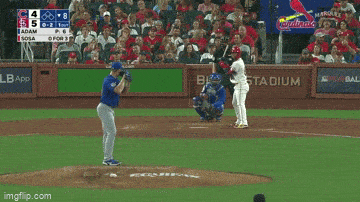
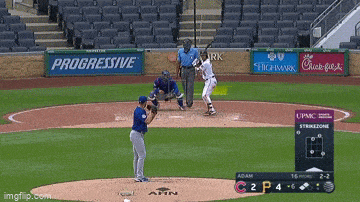
Adam has a great foundation to work with. He’s only 30 years old, and his pure stuff is filthy. Get him some work with Ethan Katz and see if he can’t teach him to throw a pitch called a strike.
Risk: The risk is pretty minimal with relievers in general. In Adam’s case, however, the risk is that he doesn’t learn to throw a strike and remains unable to harness his filthy stuff. That makes him no better than Jose Ruiz or Ryan Burr in terms of filling a roster spot. Adam also has had a problem staying healthy and on the field in recent seasons. He suffered a pretty gruesome ankle injury to begin 2021 but ended the season on the field. In reality, if this is the extent of the risk, this is as minimal as it gets.
Final Thoughts: There’s very little risk associated with taking a flier on a relief pitcher. Given Adam’s elite stuff, as well as the White Sox’ lack of overwhelming inspiring options outside of Kendall Graveman, Liam Hendriks, and Aaron Bummer, the team should take a shot on Adam earning a spot in Spring Training. Low risk, high reward: that’s the name of the non-tender game.
Matthew Boyd, SP
Upside: Matthew Boyd is one of those frustrating SPs who has a ton of talent, but really hasn’t been able to put it all together. In his career with the Tigers, he was constantly a 4.00 ERA-ish pitcher with a frustrating amount of potential. He looked like he had finally turned it around in 2021 – trading strikeouts (career-low 19.9% strikeout rate) for better control (2nd-best career mark at a 6.8% walk rate), and had a 3.44 ERA and 3.75 FIP in 13 starts before an injury and eventual surgery to repair his flexor tendon.


As you can see with the movement on his pitches, he has a world of potential. All of his pitches have a considerable amount of movement – with his slider being his best offering.
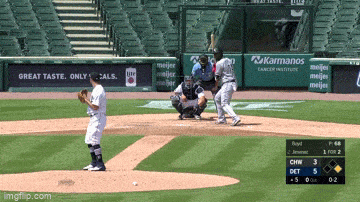
He’s thrown 175-180 inning multiple times in his career, and at worst, when healthy, he’s a mid-rotation starting pitcher. This is exactly who the White Sox should be looking for in order to best manage Michael Kopech’s and Dallas Keuchel’s innings throughout this season. Hopefully, Ethan Katz could continue the solid progress Boyd made in 2021.
Risk: Obviously, the biggest risk here is that Matthew Boyd is not scheduled to return from his injury until June at the earliest. That would give the White Sox about 2-3 months without his services. While this necessarily wouldn’t impact his ability to help the Sox manage innings in the long run, it wouldn’t help them in the case of injury in the first few months of the season. Boyd would be nice depth, but he wouldn’t be a solution to the question of load management – at least early on in the season.
Final Thoughts: There would be very little risk to giving Boyd a one-year deal with a second-year option. Let him prove he’s healthy and still a really solid pitcher throughout 2022, with the opportunity to provide the Sox depth in 2023 or cut ties if it isn’t worth it. This is yet another low-risk, high-reward player, though he might not be a perfect solution to some of the Sox’ problems.
Johan Camargo, IF
Upside: Johan Camargo has spent a lot of time trying to re-capture the magic of his 24-year-old 2018 season. After slashing .272/.349/.457 that season, he has since slashed just .212/.260/.361 and spent most of the 2021 season down in AAA at the age of 27.
Despite his offensive shortcomings, he’s been a solid defender over the course of his career while playing both 2B and 3B. He serves as the perfect form of depth behind Leury Garcia and Romy Gonzalez, especially given the fact that Camargo still has one more option year left that the White Sox could use, if necessary, out of Spring Training and throughout the season. The White Sox don’t have much infield depth as it is, which would provide Camargo plenty of opportunities at both the AAA and MLB level, should he (likely) not find a starting job elsewhere.
Risk: Again, very little true risk in a move like this. But, the reality is that Camargo may never capture that 2018 season again, and if he doesn’t, he becomes a liability at the plate that the Sox really couldn’t count on if they needed to over a long period of time. But, a cheap insurance option with a minor league option still carries very little risk, outside of having to use a 40-man roster spot to do so.
Final Thoughts: This is absolutely nothing flashy, but there’s very little downside to giving the switch-hitting Camargo a chance with the South Siders. Perhaps a change of scenery helps him out a bit. But, at worst, him serving as minor league depth doesn’t block anyone’s development and serves as a useful “Break Glass in Case of Emergency” scenario.
Chad Kuhl, SP/RP
Upside: Chad Kuhl is one of the most interesting names on this list in terms of his potential. His career numbers are nothing eye-popping: 4.44 ERA, 4.61 FIP, 22% strikeout rate, 10% walk rate. However, take a peek under the hood, and there’s some raw talent: high fastball velocity, good spin rates on his offspeed pitches. Something might be there, despite the results.

Let’s be honest: the Pirates haven’t been historically good at developing pitchers. They tend to teach them sinkers, even if they aren’t incredibly effective pitches. Credit where it’s due, however, as the organization decreased Kuhl’s sinker usage this year to its lowest career mark and significantly ramped up the usage of his best pitch – his slider, which has always had a 30%+ whiff rate.
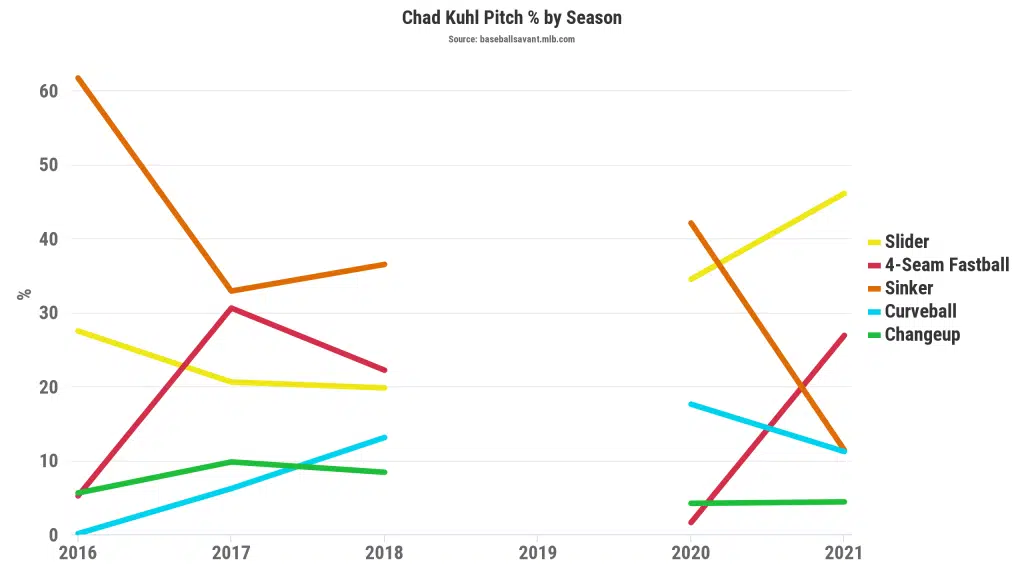
Kuhl did have spurts of really good stuff this season, which won’t be seen in the overall 4.82 ERA and 5.31 FIP. He would need to make drastic changes to serve as anything more than depth. But could working with Ethan Katz, given his raw stuff, create a solid Reynaldo Lopez-like situation in which Kuhl could bounce between the rotation and bullpen as needed?
Risk: Common theme here – not much. The risk is that the White Sox waste a 40-man roster space on someone whose innings become as meaningful as Jose Ruiz’s. With these sorts of non-tenders, it’s clear that something wasn’t working out in the current situation. But that doesn’t necessarily mean it’ll work out anywhere else, which is the obvious risk here for the Sox. Basically, it’s not a guaranteed solution to the White Sox’ problems.
Final Thoughts: Kuhl was always highly thought of, but never panned out. Perhaps the White Sox are past the point of taking on new cases and hoping they work out. But I don’t think they necessarily are, given that Jose Ruiz and Ryan Burr currently hold projected bullpen spots. Give the new pitching coach a chance to work his magic, and see what happens.
Richard Rodriguez, RP
Upside/Risk: Richard Rodriguez was a popular name last offseason among Sox fans who wanted to see the team grab a good reliever from a rebuilding team. Instead, Rodriguez finds himself non-tendered by the Braves after posting a 2.94 ERA.
The 2.94 ERA looks pretty solid, right? That’s held up by a 16.7% strikeout rate, which is down from a 36.6% strikeout rate in 2020. What could’ve led to that decline? Given that the general pitch shape and velocity didn’t change for Rodriguez from season to season, that forces us to look at pitch usage:
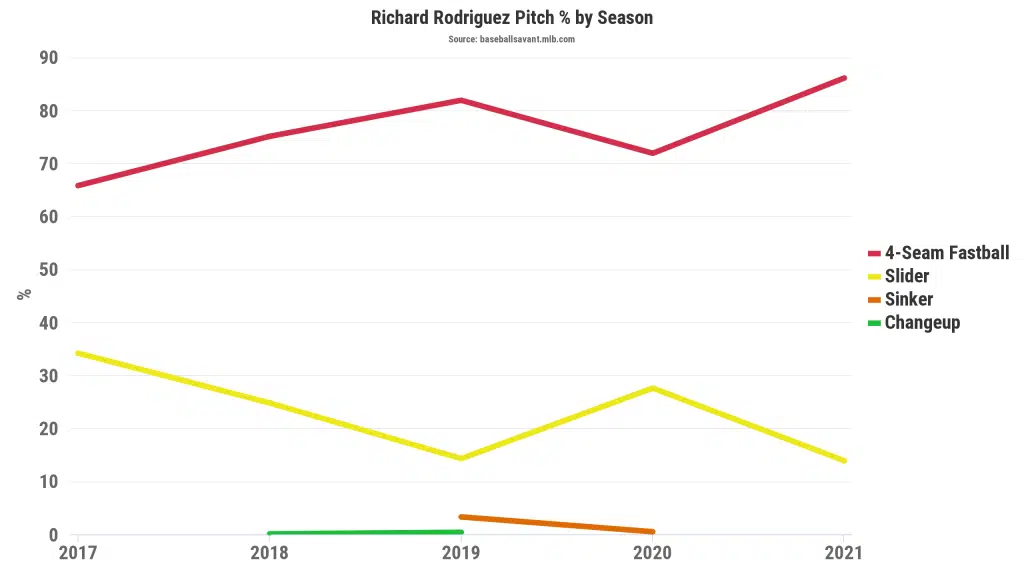
Ah, there’s something. Rodriguez, after pitching to a 70%/30% pitch mix in 2020, became way more predictable in 2021, going to an 85%/15% pitch mix between his fastball and slider.
But wait, there’s more. Both of his pitches saw a significant decrease in whiff rate. Here’s his spin rate by month:
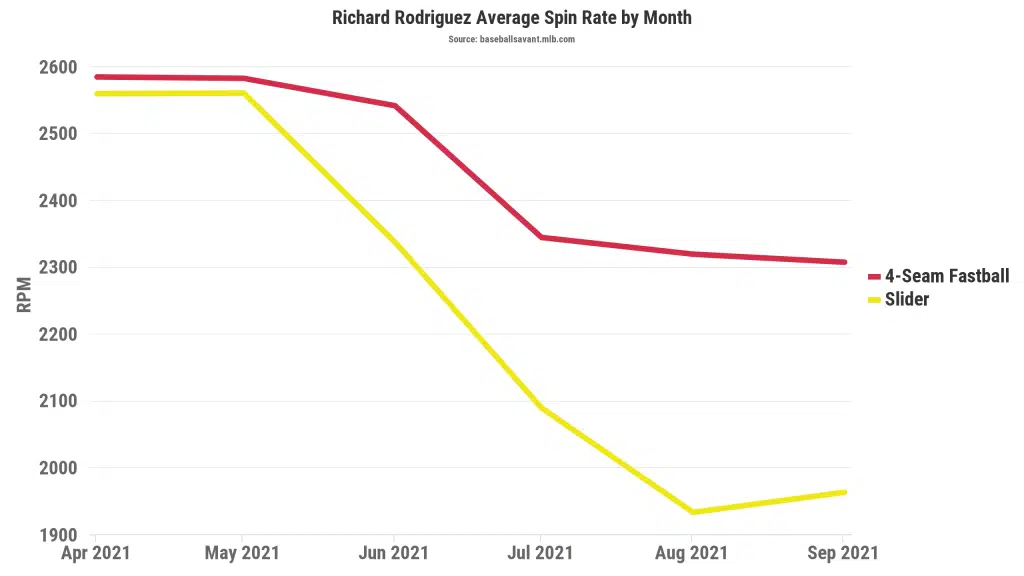
Remember that “sticky stuff” ban in June? That makes this dropoff more than just a little bit suspect. The ban is the likely culprit for his dropoff.
That’s more than a little bit concerning. Rodriguez could easily be a “one-year wonder” type of pitcher, as relievers are naturally pretty volatile. That risk is compounded by the fact that Rodriguez’s stuff dropped off so drastically after the ban. Perhaps some work over the winter will allow him to adjust better than when he was trying to adjust on the fly, but it’s clear there is work to be done.
Final Thoughts: The point of this exercise is to identify those players with the potential to make an impact. Because of previous success, and a clear indicator of what might’ve gone wrong for Rodriguez in 2021, I’d be willing to take a chance. If he can’t increase some of his spin metrics back to near pre-ban levels, I doubt the White Sox would be able to let him break the Opening Day roster.
Others Considered Outside of the Top 5
C: Grayson Greiner, Yohel Pozo
The White Sox need a backup catcher of some sort. Greiner is a pretty uninspiring option, but he does come with solid major league experience from a division rival. Pozo is a bit more interesting, despite the fact that he appears to be allergic to walking. He had a decent cup of coffee in the big leagues last season, posting a .690 OPS in 77 PAs – good enough for a backup catcher. He looks to be a decent framer too, but that’s really yet to be determined given the small sample size. He’s usually hit pretty well in the minors, so it might be worth giving him a shot to break camp with the team. It’s not like the Sox have a ton of options here anyway.
IF: Daniel Vogelbach
If the White Sox are looking for a left-handed masher, they might consider Vogelbach. However, his 2021 .381 SLG is a far cry from his best season of a .439 SLG, and even that number isn’t overly impressive given his profile as a LH slugger. His career 15.7% walk rate is personally pleasing to my eye, and if the White Sox end up trading Gavin Sheets, this could be a move worth considering.
OF: Luis Gonzalez
Bring an old friend back in the name of minor league depth, why not?
RP: Trey Wingenter, Matt Strahm, Taylor Clarke
The common thread between Wingenter and Strahm is that they will be coming off of injuries, but they both have really good stuff. I would love the White Sox to take fliers here, but they are higher risk due to their injuries. Clarke isn’t coming off of injury – rather, just a stretch of ineffectiveness with a 4.99 ERA. Last year was Clarke’s best year in terms of his walk rate, and a 3.54 FIP shows there might be some room for improvement over his 2021 results. However, he’s the least intriguing of all the bullpen names mentioned, despite his ability to start games in a pinch.
I’ve written an article like this over the past three years now, and honestly, this was the season with the fewest intriguing options on the market after the non-tender deadline. It’s a combination of player quality and just the current contract structure that created this, and as a result, it’s clear that the White Sox won’t find too many bargains being added to the market after this deadline. There is potential here, however, that I feel is worth exploring – it’s just potential that likely won’t find a home anytime soon, especially before the lockout.
If Rick Hahn and Co. want to make additions, their best choices were already on the market. With the lockout looming just hours away, hopefully, it’s not too long before everyone can get back to work.
Send me your thoughts on Twitter @jlazowski14 or reply below!
Featured Photos from Cubs, Pirates, Braves, and Tigers Twitter, respectively
